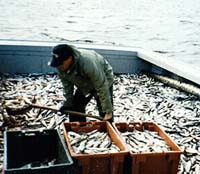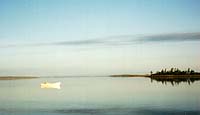








The early French explorers told of the abundance of fish surrounding the islands in the Gulf of St. Lawrence. In their journals, they wrote about seeing the water all around their vessels black with cod, and listening as thousands of fish bumped against their hulls. Sailing into the Gulf of St. Lawrence was like sailing on a sea of fish. Cod was an important part of the European diet, as the Catholic church dictated that fish must be eaten every Friday. In the 1700s, French fishermen would come and live on the shores of the Island (then called L'Ile St-Jean) to fish from early spring until late fall, after which they would return home with the flaked and dried fish.
By the early 1800's, Americans were also
fishing in the Gulf waters and continued to do so
throughout the nineteenth century, according to
reciprocal treaties they had reached with the British and
Canadian governments. At the start of the nineteenth
century, Islanders were not involved in the commercial
fishery on any large scale. Because of the availability
of fish, however, settlers depended on it to supplement
the often less reliable supply of food coming from their  recently
cleared farmland. Cod, shellfish, and eels were all
staples in the diet of early settlers. Fish was mixed in
with the feed for farm animals, as well as being used as
fertilizer on the fields.
recently
cleared farmland. Cod, shellfish, and eels were all
staples in the diet of early settlers. Fish was mixed in
with the feed for farm animals, as well as being used as
fertilizer on the fields.
By the mid-nineteenth century, fishing was becoming less and less of a survival tactic and more a way of making a living. In 1860, there were approximately 2,300 people engaged in the fishing industry on the Island. The chief groundfish exports were cod, herring, gaspereaux, mackerel, and cod liver oils-- much to the chagrin of children everywhere. The main fish harvested off the shores of P. E. I. was mackerel, and its rich white flesh proved to be a solid seller.
 The 1886 letters of a
Mr. John T. O'Brien tell how he travelled to P.E.I. in
search of work with one of the fishing establishments on
the north shore. Luck was on O'Brien's side. When he
arrived at the Kensington railway station, he was offered
a ride by a relative of Neil Macleod, who owned one of
the local fish operations. O'Brien and the driver of the
rig got to talking, and before the ride was over, he was
promptly offered a job. He describes in great detail how
the hands on board made their living from mackerel
catches. The men kept half of the catch and sold it
themselves, and the other half went back to Macleod to
pay for their living quarters in the boat.
The 1886 letters of a
Mr. John T. O'Brien tell how he travelled to P.E.I. in
search of work with one of the fishing establishments on
the north shore. Luck was on O'Brien's side. When he
arrived at the Kensington railway station, he was offered
a ride by a relative of Neil Macleod, who owned one of
the local fish operations. O'Brien and the driver of the
rig got to talking, and before the ride was over, he was
promptly offered a job. He describes in great detail how
the hands on board made their living from mackerel
catches. The men kept half of the catch and sold it
themselves, and the other half went back to Macleod to
pay for their living quarters in the boat.
![]() The cod fishery grew steadily
throughout the nineteenth century, despite some of the
problems posed by the Island climate. The summer sun
sometimes was too hot to dry the cod properly, and the
sand from the dunes would often blow over the prepared
fish.
The cod fishery grew steadily
throughout the nineteenth century, despite some of the
problems posed by the Island climate. The summer sun
sometimes was too hot to dry the cod properly, and the
sand from the dunes would often blow over the prepared
fish.
The rise of the oyster fishery in the mid-1800s was a major boon to the Island fishing industry. Between 1876 and 1910, over 850,000 barrels of the unsightly-- but delicious-- shellfish were pulled from Island waters, with over half of this amount coming off the shores of Malpeque Bay. Malpeque oysters were entered in the International Exposition in Paris in the 1880's and won the title for the world's best. The Island oyster, rumored to be a natural love-potion, took the City of Love by storm!
Perhaps Island oysters became too famous, however, because their popularity led to overfishing. The molluscs all but disappeared from some bays around Prince Edward Island, and a once bountiful area like Malpeque was reduced to a shadow of its former harvests. While the industry went into rapid decline in the 1930s, it has managed to survive to the present day, with 179 fisherman active in 1997.
Besides oysters, Islanders also fish other molluscs, such as soft shell clams, bar clams, quahaugs, and mussels. The past decade has seen dramatic growth in the export of cultured mussels, and there are now over a hundred mussel fishermen on the Island. These fishermen-- sometimes called mussel farmers-- maintain and harvest their mussel lines all year round, even hauling the blue molluscs through the ice during the winter season.
Fishermen have filled their nets in Island
waters for over two hundred years, and it once seemed
impossible that the sea's abundance would ever diminish.
But now, Islanders are now starting to feel the hard
consequences of overfishing. The federal moratorium in
the ground fish sector has left boats tied up, bringing
financial hardship to Island fishermen. While there were
once more than 850 ground fishermen, the number still has
dwindled to just over 300, and catches  are
only a fraction of what they used to be. Some are
concerned that the lobster fishery is headed in the same
direction as the ground fish sector. Hopefully, the
lessons of the past can prevent the cod from joining the
endangered species list, a proposition that would have
seemed unimaginable for the first French fishermen who
sailed into the Gulf.
are
only a fraction of what they used to be. Some are
concerned that the lobster fishery is headed in the same
direction as the ground fish sector. Hopefully, the
lessons of the past can prevent the cod from joining the
endangered species list, a proposition that would have
seemed unimaginable for the first French fishermen who
sailed into the Gulf.